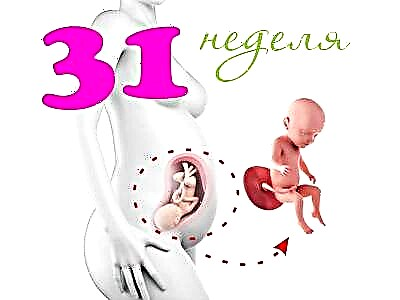
The last period of bearing a baby is very important. At this time, the expectant mother must be very careful to monitor her well-being and changes in her analyzes. One of the most important indicators is hemoglobin.

What is it determined for?
Before birth, the baby gets all the soluble substances necessary for it to fully develop through the blood. Hemoglobin is a kind of their carrier.
Its structure is based on protein molecules and heme iron. It is this combination that allows you to transfer all the necessary substances into the baby's body.
By the third trimester of pregnancy, the child has already grown up enough and takes up a lot of space in the mother's tummy. All of his organ systems continue to develop and differentiate. This leads to the fact that the need for nutrients increases significantly.

A decrease in this protein substance in the blood is not at all a consequence of some pathology. After the baby is born, the hemoglobin level gradually normalizes.
By the beginning of the 3rd trimester, physiological blood thinning... This is invented by nature so that nutrients can more easily penetrate the developing baby.
Doctors prescribe a complete blood count for all pregnant women in the final period of pregnancy. With this test, you can determine the number of red blood cells and hemoglobin. A decrease in these indicators is a sign of an anemic state. Such a pathology is unfavorable for both the mother and her baby.

Norms
In the population, the normal values of this substance in the blood are from 120 to 140 g / liter. They change significantly during pregnancy. This feature is largely due to the fact that the mother's blood flow for all 9 months provides not only her needs, but also the baby's body with all the substances necessary for him.
In different weeks of pregnancy, the reference values of hemoglobin in the blood are slightly different. In order to easily identify signs of various disorders, doctors use a special table. It is presented below:
Analyzing the given values, it can be noted that a reduction of less than 110 g / liter is already undesirable. It is important to note that not all expectant mothers change hemoglobin. In some women, it may increase in the third trimester. In such a situation, it is imperative to ensure that its values do not exceed the maximum permissible values.

What do the changes indicate?
In the third trimester of pregnancy, changes in the concentration of hemoglobin in the blood are quite common. Various reasons lead to a decrease or increase in its level.
Increased blood concentration
By the third trimester of pregnancy, the hemoglobin level in the blood should not exceed 140 g / liter. If this indicator changes, this may be evidence that the expectant mother has any pathologies of internal organs.
Quite often, various gastrointestinal diseases, deficient states of B vitamins, as well as in some serious diseases of the cardiovascular system, lead to such a situation.

The excess of this indicator above the norm is an extremely unfavorable sign. It can lead to increased blood clots. The appearance of small blood clots in the uteroplacental blood flow system is extremely dangerous.
They can block the lumen of the blood vessel, leading to malnutrition in the fetus. If this pathology lasts long enough, then this will contribute to the development of the baby's hypoxic state.
Before giving birth, this condition can be extremely unfavorable. At the same time, the risk of premature birth increases several times. In some cases, doctors will even resort to prescribing a caesarean section.

Decreased blood concentration
The longer the pregnancy, the lower, as a rule, the level of hemoglobin in the blood. Only by the very last weeks of intrauterine development of the fetus, this indicator gradually increases.
If the expectant mother is carrying several babies at the same time, then the concentration in the blood of this substance is significantly reduced. Also, bearing a too large baby can lead to a pronounced decrease in hemoglobin.
Women who practice vegetarianism are at high risk on the development of a deficiency of this substance in their blood. The depletion of the diet with heme iron leads to the gradual development of an anemic state.

In the first months of bearing a baby, it may not be pronounced significantly. By the 3rd trimester, violations begin to intensify.
If the hemoglobin level is already 105-109 g / liter, mandatory monitoring of this clinical indicator is required immediately before delivery.
In this case, doctors will definitely recommend that the expectant mother carefully monitor her diet. In order to normalize this indicator, it is often simply required to additionally include food containing iron in your diet.


In some cases, in women who carry several babies at the same time, the hemoglobin level can decrease to 99-100 g / liter. In such a situation, careful monitoring of the state of the pregnancy is required, as well as compliance with the recommendations that the doctor will make to raise the level of hemoglobin in the blood.
The mom-to-be may not feel anemia at all. Usually, women “write off” all the unfavorable symptoms that appear in them for fatigue and a long pregnancy.
If the expectant mother began to tire very quickly even without exercising or constantly wants to sleep during the daytime, then this may be a sign of a mild anemic condition. In some cases, these adverse symptoms appear in women already when the indicator drops to 100-104 g / liter.


An anemic condition can be suspected, but for its verification mandatory analysis is required... You can donate blood in any medical institution - both in a regular clinic and in a private laboratory. The analysis result is ready, as a rule, in a couple of hours. After a laboratory test, be sure to consult your doctor.
With a more pronounced anemic condition, the expectant mother may experience severe attacks of dizziness. In some cases, she may even lose consciousness. In order to avoid this, the doctor will offer the woman to be hospitalized. While in the hospital, the expectant mother will receive intensive treatment, which will help to normalize the level of hemoglobin in her body.

What measures are taken when the indicator changes?
Already from the very first weeks of bearing a baby, the expectant mother should definitely monitor the indicators of a general blood test. Such careful monitoring will prevent the development of dangerous conditions that can cause severe harm to both her and her child. The third trimester of pregnancy is no exception.
In order for blood flow indicators to remain normal in the final period of bearing a baby, the expectant mother needs to carefully monitor her diet... She should regularly consume iron-containing foods. It is very important that their number in the daily diet should not be less than 1-2 servings per day.
The choice of treatment tactics to eliminate hemoglobin deficiency is influenced by many different factors. For this, the initial state of the woman is assessed, how many babies she carries during pregnancy, as well as the presence of concomitant diseases of internal organs.

In case of an anemic state of mild severity, the doctor will prescribe only diet therapy to the expectant mother. It is important to note that a woman should follow this recommendation until the very birth.
It takes a lot of time to normalize hemoglobin in the bloodstream. You can't get compensation in a couple of days.
To raise this substance in the blood, the expectant mother should eat lean meat. The optimal choice is veal or beef, game, chicken. The reception should be supplemented with vegetables. They contain a lot of ascorbic acid. This substance improves the absorption of heme iron.


Ascorbic acid is also found in sufficient quantities in various fruits. Drinking fruit and berry juices will be an excellent addition to the daily menu of a woman who has problems with hemoglobin in the blood during pregnancy.
If the deficiency of this protein substance in the body is significantly expressed, the doctor will prescribe various iron-containing preparations for the expectant mother. They are used for a long time and regularly.
During the use of these funds, the hemoglobin level must be monitored. With effective therapy, it will gradually increase. The most popular drugs prescribed for this condition are "Ferrum-Lek", "Totema", "Sorbifer" and many others.


If a woman has diseases of the stomach or intestines that prevent the normal absorption of ferrum into the blood, then in such a situation, iron-containing preparations will be prescribed to her in the form of injections.
When injected into the body, various local side effects can be observed. They usually occur where the medicine is injected and are called infiltrates. In order to reduce the likelihood of their occurrence, the injection technique should be followed very correctly.

After the birth of a child, a woman must also determine the concentration of hemoglobin in the blood. If a woman gives birth to a baby on her own, then her risk of developing anemic condition in the first week after giving birth is quite high.
This leads to blood loss at the birth of a baby. Already after several months, the hemoglobin level in a healthy woman should completely return to normal. If such compensation does not come, then mom must definitely go for a consultation with a therapist.
Doctor Komarovsky will tell you about the danger of a decrease in hemoglobin in a pregnant woman for a child in the next video.



